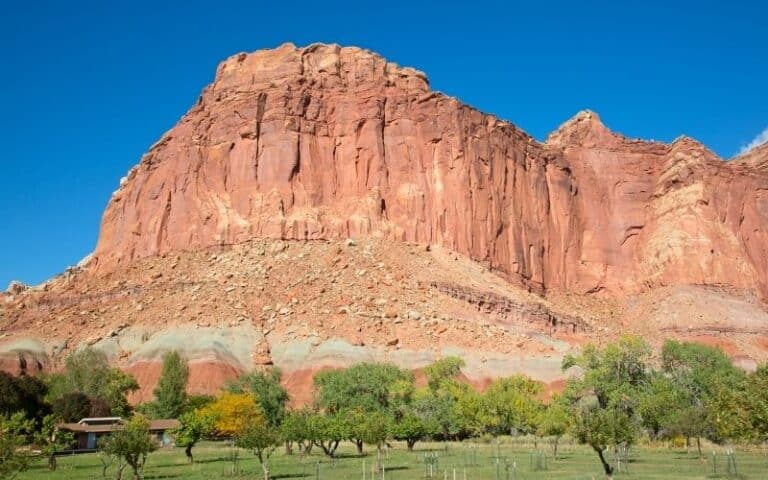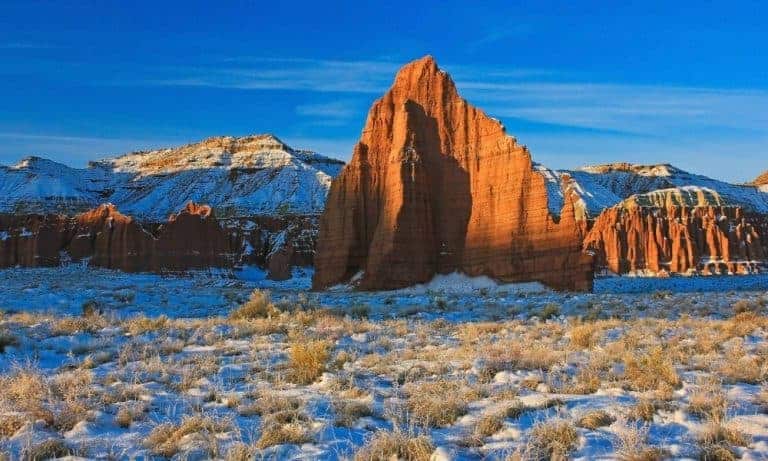Best Month to Visit Capitol Reef National Park
Capitol Reef National Park is situated in south-central Utah, stretching across nearly 241,904 acres of sandstone cliffs, ridges, and canyons.
As you begin to plan your vacation, you might ask when is the best month to visit Capitol Reef National Park? The answer depends on what you’re looking for and what kind of experience you want to have.
Use this Capitol Reef National Park guide to determine the month that’s best for you to visit for the things you want to see, do, and photograph.

To help you decide the best month to visit Capitol Reef, we share a list of activities, things to pack, travel tips, and weather information for each month of the year at the park.
Click the graphic below to get your free Capitol Reef National Park Itinerary Travel Bundle with 3 days of printable itineraries!
This site contains affiliate links which means WE may receive commissions for purchases made through these links. We only provide links to products we actually use and/or wholeheartedly recommend! As an Amazon Associate, we earn from qualifying purchases. Read the full Disclosure Policy.
A Photo Tour of Capitol Reef National Park
Take a visual tour through Capitol Reef National Park to see the stunning landscape and wildlife you’ll find in the park!
Best Month to Visit Capitol Reef National Park
Capitol Reef is the least-visited Utah National Park located between Arches and Canyonlands and Bryce Canyon and Zion.
This makes it easy to add Capitol Reef to your Utah National Park road trip itinerary if you plan to visit all five parks!
Most of the year you’ll enjoy fun outdoor Capitol Reef National Park activities like scenic drives, hiking, biking, river rafting, and photography. During the winter, the activities may be a bit more limited due to cold or snowy conditions!
It’s important to be up-to-date with the current Capitol Reef National Park weather and road conditions, especially in the winter.
Here’s our list of tips for visiting Capitol Reef every month of the year: general travel information, list of things to do, items to pack, and weather information!

Spring Months at Capitol Reef National Park
Spring is an ideal time to visit Capitol Reef National Park. Check out the fun things you can do during the fall months of March, April, and May:
- Capitol Reef National Park Spring Activities
- Capitol Reef National Park Spring Hikes
- Capitol Reef National Park Tours
Spring is a peak season, so the first part of March is your best bet to avoid the crowds when it’s spring break in Utah.
Now for the breakdown of what to expect at Capitol Reef each month in the spring.
March Vacation to Capitol Reef
When visiting Capitol Reef in March, the highs are near 55 and the lows around 31 degrees F. The weather can be unpredictable if a storm rolls through with rain, and even snow.
Even though March is technically spring, it will still feel like winter. We recommend an insulated jacket, fleece jacket, warm hat and gloves .
April Vacation to Capitol Reef
Capitol Reef National Park in April is an ideal time to visit as temperatures are mild to enjoy all the fun outdoor activities. Average highs are around 64 degrees with the lows around 37 degrees F. Bundle up in layers for the mornings and evenings that will still be cold!
The Capitol Reef Scenic Drive is a must! We recommend the Capitol Reef GuideAlong App to hear fun behind-the-scenes stories and local tips that play automatically as you drive, based on your GPS location.
May Vacation to Capitol Reef
You can expect highs near 73 and lows near 46 degrees F at Capitol Reef National Park in May. It’s the perfect weather for hiking!
There are so many fun Capitol Reef hikes to choose from, with trails for all levels of hiker.
Some of our favorite day hikes in Capitol Reef National Park are: Hickman Bridge, Grand Wash, and Capitol Gorge Wash.
The elevation at Capitol Reef is 5500 feet. If you’re coming from a lower elevation, or from sea level, trails that are considered “easy” might be more difficult for you.

Summer Months at Capitol Reef National Park
If you’re planning to visit Capitol Reef in the summer, there are things you need to know before going since it’s a HOT time of year there! Check out the fun things you can do during the summer months of June, July, and August:
The summer months are not our favorite time because it will be hot and crowded. Be sure to stay hydrated by carrying refillable water bottles, wear UV wicking clothing, apply sunscreen to all exposed skin, and you’ll want lip balm and lotion since Canyonlands is in a dry desert environment!
Now for the breakdown of what to expect at Capitol Reef each month in the summer.
June Vacation to Capitol Reef
It will be hot and dry at Capitol Reef in June in June with highs around 85 and lows around 55 degrees F.
You can’t beat stargazing at Capitol Reef National Park! The slogan “Half the Park is After Dark” invites you to take one evening to enjoy a star-filled sky! In June you can see and photograph the milky way from 10:30 pm to 3:30 am.
July Vacation to Capitol Reef
Expect highs in the 90s and lows in the mid-60s degrees F at Capitol Reef in July! You won’t find many shady spots in the park. We suggest you plan your outdoor activities like hiking in the cooler mornings and evenings.
Our big tip to avoid the crowds and heat is to get into the park early. You can’t beat Capitol Reef National Park photography at sunrise!
August Vacation to Capitol Reef
Capitol Reef in August you’ll find highs near 88 and lows near 63 degrees F.
Check out what Capitol Reef ranger-led programs are available in August. If you’re visiting the park with kids, be sure to grab the Junior Ranger booklet so they can earn their Junior Ranger Badge!

Fall Months at Capitol Reef National Park
Capitol Reef in the fall is a very busy season so be prepared for crowds. Check out the fun things you can do during the fall months of September, October, and November:
With the cooler temperatures at night and the early mornings, especially late fall, be sure to dress in layers and carry a fleece jacket, winter hat, and winter gloves.
Early fall is a terrific time for Capitol Reef National Park camping when it’s not too hot, too cold, or rainy!
Now for the breakdown of what to expect at Capitol Reef each month in the fall.
September Vacation to Capitol Reef
The fall season begins at Capitol Reef National Park in September. Expect highs around 80 and lows around 55 degrees Fahrenheit.
The Capitol Reef Fruita area is the main part of the park where you’ll find the Visitor Center, Gifford Homestead, blacksmith shop, barn, orchards, and campground.
Stopping at the Gifford Homestead you’ll find unique handmade items in the shop. You’ll also enjoy locally baked fruit pies and homemade ice cream!
Picking fruit from the orchards is a popular activity at Capitol Reef! In September you’ll be able to pick peaches, pears and apples, yum! Here’s a Capitol Reef harvesting schedule if you want to arrange your vacation around those dates.
October Vacation to Capitol Reef
The temperatures at Capitol Reef National Park in October are just right with highs about 65 degrees with the lows around 40.
If you’re up for an adventure, drive yourself, or book a tour. to explore the remote Cathedral Valley District of Capitol Reef. Usually, vehicles with high ground clearance, even without four-wheel drive, can drive the roads without difficulty. BUT if it rains, the roads can be muddy, washed out, and impassable to the best high-clearance four-wheel drive vehicle, so check at the visitor center before heading out!!
November Vacation to Capitol Reef
The temperatures at Capitol Reef National Park in November range from highs near 50 degrees and lows in the upper 20s degrees F.
The park is transitioning to the off-season so there aren’t as many visitors which is so nice! With temperatures cooling off, we like to carry rechargeable hand warmers for the cold temperatures when we’re out taking pictures at our favorite photo spots in Capitol Reef:
- Sunrise: Panorama Point and Sunset Point
- Sunset: Panorama Point, Sunset Point and along the scenic drive

Winter Months at Capitol Reef National Park
Check out the fun things you can do during the winter months of December, January, and February:
In the winter many of the Capitol Reef services have changed hours or have closed for the season. Check the website for specific Capitol Reef operating hours.
After a snow storm, paved roads may close temporarily so crews can plow. Unpaved backcountry roads may be impassible for longer periods of time so check road conditions before you head out!
Now for the breakdown of what to expect at Capitol Reef each month in the winter.
December Vacation to Capitol Reef
We enjoy the winter months because it’s nice to explore Capitol Reef without the crowds and daytime heat you find in the summer.
But the weather in December can be unpredictable with snow and cold temperatures so it’s not for everyone. The average highs are around 40 degrees with the lows around 20 degrees F.
Pack winter hiking gear and dress in layers when visiting in the winter. The hiking trails remain open year-round, but you may encounter snow and ice which may require traction devices and trekking poles.
January Vacation to Capitol Reef
The weather at Capitol Reef National Park in January is cold and can be unpredictable. The average highs are 39 degrees with the lows 18 degrees F.
The only option for Capitol Reef National Park winter camping is at the Fruita Campground. It’s open year-round, and is the only developed campground in the park.
It has 71 sites, and each site has a picnic table and firepit and/or above ground grill, but no individual water, sewage, or electrical hookups. During the winter from November 1 – February 28, all campsites are first come, first served.
You’ll also find great off season rates at the hotels near Capitol Reef National Park!
February Vacation to Capitol Reef
The average highs at Capitol Reef National Park in February are near 45 degrees with the lows near 23 degrees F.
Take warm winter clothing and dress in layers so you’ll actually want to get out of the car when you get to the trailhead. Wear waterproof hiking boots so you don’t get soggy feet!
After a snow storm, the park road might be closed for plowing for a few hours. Keep in mind that the roads, parking lots, and pullouts in the park can still be icy, especially in shaded areas. You can see current weather conditions on the NPS website.
Packing List for Canyonlands
Be sure to use a Capitol Reef National Park packing list so you have the right clothing and gear to enjoy all the outdoor activities any time of year! Grab your free printable packing list by clicking the image below!









